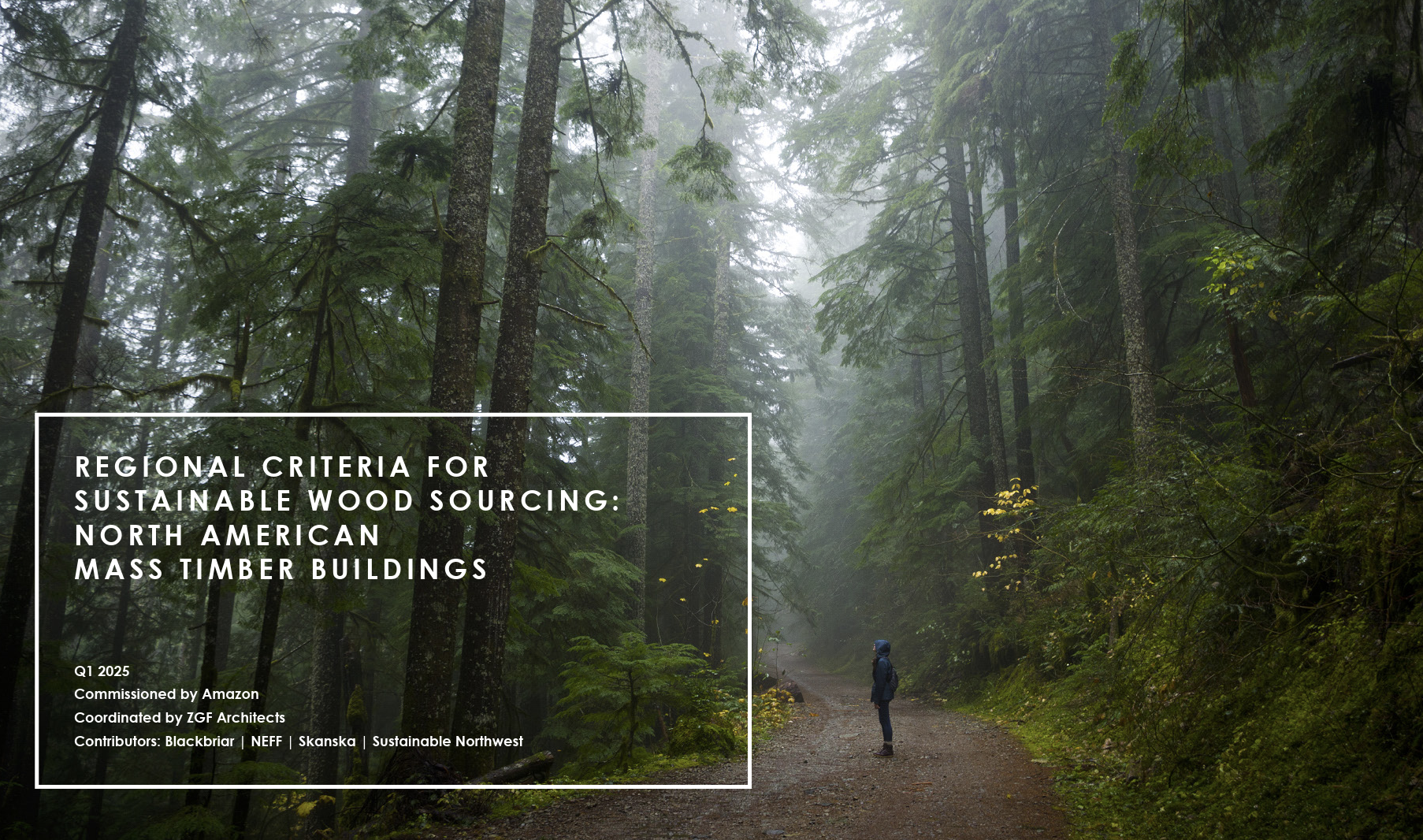Mass Timber at Mass Scale
Turning warehouse construction into an investment in forests
In 2024, Sustainable Northwest partnered with Amazon on a bold, visionary project: to reimagine the materials used in their vast network of warehouses in a way that aligns with the company’s sustainability commitments, supports forest health, and drives change across the building industry.
Amazon builds hundreds of new facilities each year. That scale comes with both opportunity and responsibility. Recognizing that materials like steel and concrete are carbon intensive, Amazon commissioned Sustainable Northwest and others to describe first management best practices aimed at improving the ecological, social, and climate health of North American forests. The region-based criteria outlined in the document helps support transparent wood procurement methods.
A 10% Market Driver
The implications are huge. If Amazon starts sourcing mass timber to build warehouses, they could instantly become one of the largest single buyers of mass timber in the U.S.—potentially driving 10% of the entire market. “That kind of demand, if tied to ecological values and transparency, has the power to reshape the market,” said Paul Vanderford, senior director of wood markets for Sustainable Northwest.
Amazon enlisted nationwide experts to answer the question: How can we anchor our sourcing decisions in science and forest stewardship so we can spend our dollars wisely, honestly, and impactfully? The experts included ZGF Architects, Sustainable Northwest, Blackbriar, New England Forestry Foundation, and Skanska.
Mapping the Forest Landscape
To answer that, Amazon drew together several partners to map the forest landscape throughout the U.S. and Canada. Sustainable Northwest and ZGF worked together to analyze the U.S. West Coast, Rocky Mountains, and Western Canada – and forestry experts in New England and the South were hired to analyze those regions. The scope included identifying:
Land ownership patterns (federal, state, Tribal, small private, industrial)
Forest types and species composition
Forest conditions and recommended forest treatments
Forest health risks (wildfire, drought, conversion)
They developed a framework for evaluating forest management on a continuum “Good, Better, Best”— recognizing that building North American warehouses with wood sourced from North America is a good starting position that offers opportunity to achieve additional value. The continuum includes the full range of management tools and harvesting practices, attention to Indigenous and community values such as clean water, recreation, wildlife habitat, and more.
This resulted in a full regional picture of forest health, ecological integrity, and opportunity for investing in a future with a positive human footprint.
Who's Ready to Step Up?
But Amazon didn’t stop at forest ecology. They also wanted to know: Who’s manufacturing mass timber in these regions? Where do they source their wood? And would they be willing to prioritize transparency and forest outcomes to work with Amazon?
SNW and ZGF met with every major mass timber manufacturer in the western U.S. to ask just that. The response was overwhelmingly positive. With a “nothing to hide attitude” every company said they were open to working with Amazon to help them achieve their vision—just like the partners we assembled for the Portland airport project.
“In essence, Amazon is working toward having an ‘Angie’s List’ of mass timber suppliers – complete with the transparency, sourcing regions, and ecological data they need to make informed decisions. The transparency back to source forest is not there yet, but Amazon is pushing the envelope in that direction,” Vanderford said.
Raising the Bar for Industry
This work arrives at a pivotal moment. Leading green building standards by the International Living Future Institute and U.S. Green Building Council are expanding their criteria to emphasize intentional, place-based material sourcing. What Amazon is doing aligns closely with these evolving standards – as well as the Transparency Pledge that we have supported as a market signal, which dozens of companies have signed.
The future of wood is not just renewable – it’s intentional, transparent, and restorative. This project proves that large-scale buyers can lead with values, and that forest owners, manufacturers, and designers are ready to meet them there.
From Big Tech to Big Change
We’ve heard critics say this approach only works for bespoke projects and on a small scale. We are excited by a good challenge and we’re thrilled to be testing our work at the biggest scale yet. In fact, Amazon isn’t our only client doing this work – SNW is working with several major tech companies, developers, building firms, Indigenous communities, public agencies, and private forest owners to support over a dozen projects US wide to advance this approach across the sector.
With their latest mass timber projection Indiana, Amazon has shown their willingness to invest in greener solutions like sustainable, regionally sourced mass timber.
Shared Knowledge, Shared Future
While Amazon owns the report, they’ve made it clear they want the intellectual groundwork to be shared and used broadly. This isn’t just about one company—it’s about building a new model for how materials are sourced, forests are managed, and dollars are spent.
If you’re excited about this work, you’re not alone—and we’re just getting started. We look forward to working with you on a project in the future!
All of Amazon’s resources about building decarbonization can be found in the building section of the Amazon Sustainability Exchange.

